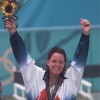By Randy Walker
@TennisPublisher
Lindsay Davenport leads the “Class of 2014” at the International Tennis Hall of Fame induction in Newport, R.I. The induction provides a platform to relay memories of when she first burst onto the top of the tennis scene in 1996.
I first met Lindsay at the U.S. Open in 1993 when she was just 17, one year removed from her winning the junior title at Flushing Meadows. She was one of the U.S. players I was promoting as part of my USTA publicity duties with top up-and-coming American players in conjunction the USTA Player Development program.
Three years later in 1996, I was fortunate enough to serve my first stint as press officer for the U.S. Olympic tennis team at the Atlanta Games. Lindsay barely made it onto the U.S. team as the last singles player on a squad that also featured co-world No. 1 Monica Seles, top-ten player Chanda Rubin as well as defending gold medal doubles champions Mary Joe Fernandez and Gigi Fernandez.
At the U.S. team pre-event press conference before the competition began, Lindsay was sitting on the stage with seven of her teammates – Seles, Rubin, Mary Joe and Gigi Fernandez as well as men’s team members Andre Agassi, Mal Washington and Richey Reneberg and U.S. coaches Billie Jean King and Tom Gullikson. It was curious that of all the questions asked by media during this press conference, not one was directed to Lindsay. She was the only team member to be silent during the session.
As the tennis competition started, Lindsay moved through the draw as quietly as she sat through the pre-event team press conference. With upsets of No. 5 seed Anke Huber of Germany and No. 4 seed Iva Majoli of Croatia, Lindsay, the No. 9 seed, reached the semifinals where she met teammate and close friend Mary Joe Fernandez, a replacement for an injured Rubin in the singles draw. It was an emotional match between Lindsay and Mary Joe – both being such great friends – but Lindsay pulled the minor upset of the more experienced Fernandez 6-2, 7-6 (6) and surprised the tennis world by reaching the final against former world No. 1 Arantxa Sanchez-Vicario.
The day before the gold medal match, we booked Lindsay on a media junket in downtown Atlanta to help get some much needed publicity towards Olympic tennis, which at the time was still in its nascent stages as an Olympic sport, having returned to the Games after a 64-year absence just eight years earlier. Tennis was almost a forgotten Olympic sport, still trying to find its identity on the Olympic landscape. As we shuffled between media outlets and TV stations around Centennial Olympic Park, it was a bit unusal to see that no one really recognized or paid much attention to Lindsay when we walked through crowded fan areas. Standing at over six-feet tall, it was hard not to mistake her for an athlete in this Olympic environment.
The next day in the gold medal match, Sanchez-Vicario was the heavy favorite – so much so that Juan Antonio Samaranch, the President of the International Olympic Committee, had bestowed upon himself to be the IOC official who would award the medals at the tennis event that day, believing that he would be presenting gold to his fellow Spaniard Sanchez-Vicario. But Lindsay pulled a stunner – not quite the U.S. Olympic hockey team upsetting the Soviets at the 1980 Winter Games – but she surprised Sanchez-Vicario 7-6 (8), 6-2 in the final. The player who no media member had even bothered to ask a question to in the pre-event press conference was the Olympic champion. Samaranch placed the gold medal around Davenport’s neck and silver around Sanchez-Vicario’s.
The day after the gold medal match, we returned to downtown Atlanta for an even more crowded media junket for the newly-crowned gold medalist, visiting CNN, ESPN, NBC, MSNBC and others. We walked down the same route where Lindsay was completely unnoticed just 48 hours earlier, but now she was being greeted with constant barrages of shouts of “USA” and “Way to go Lindsay” while posing for numerous photos. It’s amazing what winning a gold medal will do for your notoriety. All the while, Lindsay kept her gold medal neatly tucked in her front pocket, out of sight until she needed to bring it out for her media appearances.
Even though it was five years before the September 11 attacks on the United States, it was just a week after the Centennial Olympic Park bombing and security was tight. Entering TV studios required going through metal detectors, which is what we had to do and, as Lindsay walked under the arches of the detector, she set it off. The security official was one of the few people during the day who did not recognize the new Olympic golden girl and asked politely for Lindsay to empty her pockets of “any metal objects” and to place them in a non-descript blue plastic dish to the side. Lindsay reached into her pocket and took out her Olympic gold medal, placing it in the plastic dish before walking again through the detector. The security official, with her mouth ajar, then reached into the dish and pulled the gold medal up by its green ribbon. “Woooowwwwwwwwww,” was all she could manage to say as her eyes bulged in amazement, staring close up at the most desired object of the Olympic Games. It was a unique and amusing moment.
Two years after her Olympic win, Lindsay won her first major singles title at the U.S. Open, beating another favorite in the final, top-seed Martina Hingis. A year after that, she won Wimbledon, also in a surprise, beating 22-time major champion Steffi Graf in the final. Another year later, she added the Australian Open to her collection of major singles titles. Now, 18 years after winning Olympic gold in Atlanta, she’s a Hall of Famer.

